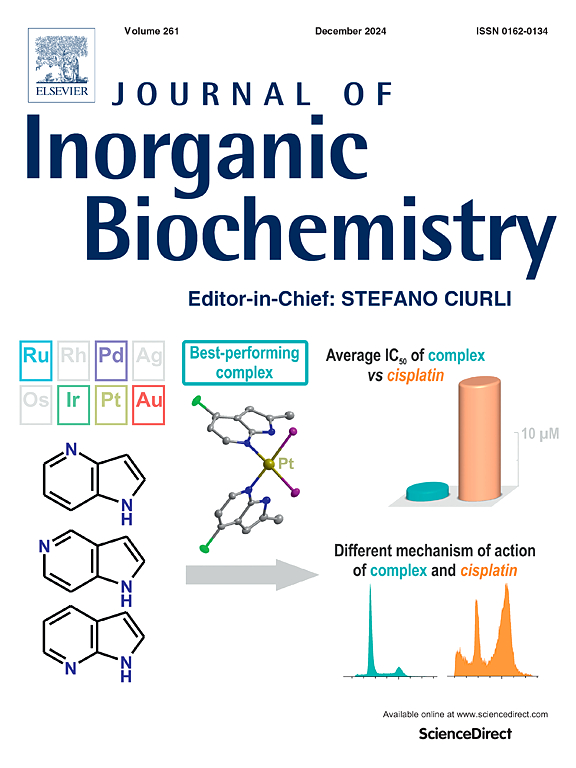揭开机制:来自卤酸脱卤酶超家族的β-磷酸葡萄糖糖糖化酶是如何催化β-d-葡萄糖1-磷酸和β-d-葡萄糖6-磷酸的相互转化的?从化学的角度来看。
IF 3.8
2区 化学
Q2 BIOCHEMISTRY & MOLECULAR BIOLOGY
引用次数: 0
摘要
酶的催化机制可以根据其催化结构进行系统发育映射。这种图谱有效地阐明了酶催化机制的多样性和酶超家族中新的酶活性的出现。卤酸脱卤酶(HAD)超家族可以作为理解催化结构和机制共同进化的示范模型系统。本研究从化学角度探讨了β-磷酸葡萄糖糖糖化酶(β-PGM)与HAD超家族磷酸酶分支功能分化的机制。利用B3LYP函数的密度泛函理论方法构建和计算三个不同尺度的模型,探讨HAD家族β-PGM功能分化的化学机制。计算结果表明,第二壳的His20和Lys76残基稳定了底物,增强了Asp10的酸碱催化能力。此外,残基Arg49、Ser116和Asn118通过与底物紧密的氢键相互作用促进底物结合。通过协同作用,这些残基使β-PGM作为一种高效的磷酸葡萄糖糖糖化酶发挥作用。通过计算模型和化学角度,我们揭示了β-PGM将β-d-葡萄糖1-磷酸转化为β-d-葡萄糖6-磷酸的机制。最后,在进化树分析的基础上,对不同形态的水解酶金属核的进化关系进行了讨论和总结。本文章由计算机程序翻译,如有差异,请以英文原文为准。

Unraveling the mechanism: How does β-phosphoglucomutase from the haloacid dehalogenase superfamily catalyze the interconversion of β-d-glucose 1-phosphate and β-d-glucose 6-phosphate? A chemical perspective
The catalytic mechanisms of enzymes can be phylogenetically mapped corresponding to their catalytic structures. This mapping effectively elucidates the diversity of enzyme catalytic mechanisms and the emergence of new enzymatic activities within enzyme superfamilies. The haloacid dehalogenase (HAD) superfamily serves as an exemplary model system for comprehending the co-evolution of catalytic structures and mechanisms. This study delves into the mechanism underlying the functional divergence of β-phosphoglucomutase (β-PGM) from the phosphatase branch of the HAD superfamily, employing a chemical perspective. Through the construction and calculation of three models of varying scales using the Density Functional Theory method with B3LYP function, we aim to investigate the chemical mechanism driving this functional divergence of β-PGM from the HAD family. The computational results indicate that residues His20 and Lys76 in the second shell stabilize substrates and enhance the acid-base catalytic ability of Asp10. Additionally, residues Arg49, Ser116 and Asn118 facilitate substrate binding by engaging in close hydrogen bonding interactions with the substrates. Through cooperative action, these residues enable β-PGM to function as an efficient phosphoglucomutase. Through computational modeling and a chemical perspective, we unravel the mechanisms enabling β-PGM to convert β-d-glucose 1-phosphate to β-d-glucose 6-phosphate. Finally, based on the analysis of the evolutionary tree, we discussed and summarized the evolutionary relationships among different forms of metal cores of hydrolases.
求助全文
通过发布文献求助,成功后即可免费获取论文全文。
去求助
来源期刊

Journal of Inorganic Biochemistry
生物-生化与分子生物学
CiteScore
7.00
自引率
10.30%
发文量
336
审稿时长
41 days
期刊介绍:
The Journal of Inorganic Biochemistry is an established international forum for research in all aspects of Biological Inorganic Chemistry. Original papers of a high scientific level are published in the form of Articles (full length papers), Short Communications, Focused Reviews and Bioinorganic Methods. Topics include: the chemistry, structure and function of metalloenzymes; the interaction of inorganic ions and molecules with proteins and nucleic acids; the synthesis and properties of coordination complexes of biological interest including both structural and functional model systems; the function of metal- containing systems in the regulation of gene expression; the role of metals in medicine; the application of spectroscopic methods to determine the structure of metallobiomolecules; the preparation and characterization of metal-based biomaterials; and related systems. The emphasis of the Journal is on the structure and mechanism of action of metallobiomolecules.
 求助内容:
求助内容: 应助结果提醒方式:
应助结果提醒方式:


